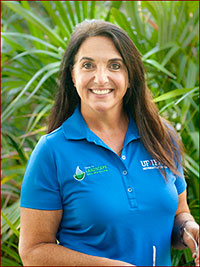Wendy's Wanderings
October 10, 2019
Bee-Friendly Landscaping
"Where there are bees there are flowers, and wherever there are flowers there is new life and hope."
— Christy Lefteri, author of "The Beekeeper of Aleppo"
And where there are flowers there are gardeners. Many gardeners are concerned about pollinator protection in their garden. In fact, a recent survey of Master Gardener Volunteers showed that 84% were interested in learning more on bees and plants that support pollinators in the landscape. We need bees, be it honey bees, bumble bees, mason bees, or the host of many native bees. They pollinate our plants and crops and support life. Is what we do in our home landscape that important to their survival?
It most certainly is. Here are some steps to take that will help support bee populations in your area.
- Plant flowers that make your yard a bee-friendly yard. Look for flower types that are flat and make good landing platforms. Also select tubular flowers with nectar at the base. Plant lots of variety of colors and shapes that bloom in different seasons. Flowers on spikes are a bee favorite. Bees favor yellow and blue flowers and cannot see red. Choose Florida-Friendly plants and Florida native plants to provide for our native bees. See this Gardening Solutions article, Perfect Plants for Pollinators, for suggestions.
- Think beyond flowers for your bee-friendly yard. Use trees and shrubs that provide pollen and nectar throughout the season. Think hollies, chaste tree, tupelo, black cherry, willows, basswood, and redbud.
- Bees get thirsty too. Provide water for the bees in shallow containers or dishes. Remember to keep the water fresh to prevent mosquitos from breeding.
- Avoid pesticides that don't have a bee-safe label. Choose the least toxic method possible for pest control and consider IPM alternatives when dealing with pests.
- Leave a natural area in your landscape. We are often quick to rake up the leaves and pick up sticks, but our solitary or ground-nesting bees use duff and natural areas to nest. Leave a few rough patches in the landscape for them. Wood blocks or nest blocks will fill quickly with mason bees or other native bees; be sure to incorporate some into your bee-friendly yard.
Amy Vu is the Extension coordinator with the UF/IFAS Honey Bee Research and Extension Laboratory (HBREL). She has a list of her favorite easy landscape plants that attract bees: African basil, beach sunflower, saw palmetto, clover, tupelo, porterweed, and Spanish needle (yes, the weed).
Dr. Jamie Ellis runs the HBREL and is a bee specialist, working with beekeepers throughout Florida and around the world. He recently recorded a podcast with WUSF News in Tampa, and it is an excellent take on Florida beekeeping; you can find it here: https://www.thezestpodcast.com/episode_23
Plant what you can to support the bees in your bee-friendly landscape, and if you are ready to kick it up a notch and start keeping your own honey bees, contact your local Extension Office for resources. You can also visit the honey bee research lab's website.
-- Wendy Wilber

